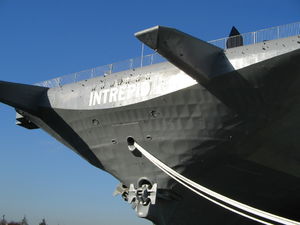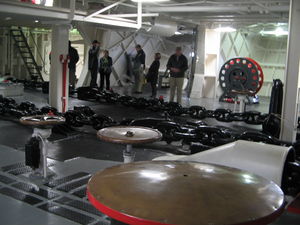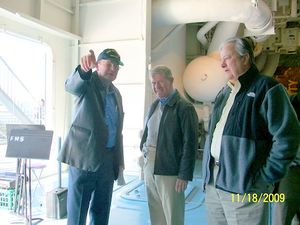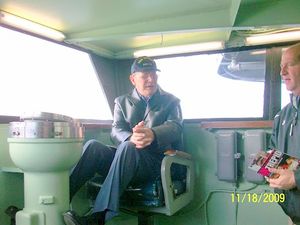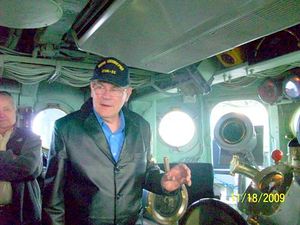First-Hand:Adventures on the USS Intrepid
Adventures on the USS Intrepid: Personal Recollections
Contributors: John W. Meredith, Senior Life Member
When I graduated from college in the mid-1960s, military service was expected of all male U.S. citizens who did not have an exemption from military service. I chose the U.S. Navy, joining a commissioning program that I completed during summer breaks while I was pursuing my BSEE degree. Following graduation I was commissioned as an Ensign and received orders to report to the USS Intrepid.
The Intrepid, I learned, was one of several super-carriers which served in WW-II during 1943-45. She had a distinguished war record having participated in several battles in the South Pacific. Following the war Intrepid, along with a number of her sister ‘flattops’, was decommissioned. In the mid-1950s she was modernized to receive an angled deck along with major improvements.
Intrepid rejoined the U.S. fleet following her modernization and was transferred to the east cost as a fleet aircraft carrier. She served with the fleet through the late 1950s to 1965 carrying out a number of miscellaneous duties such as midshipman cruises and pilot training. One of Intrepid’s notable feats was recovery of the Gemini III space capsule and her crew. I had the good fortune of learning that I would be assigned to the Intrepid on the day before the Gemini recovery. Needless to say, I intently listened to recovery activities knowing that I would soon be a crewmember of the Intrepid.
My service on Intrepid spanned two years, April 1965 to March 1967. My primary job assignment was Assistant Electronics Material Officer (AEMO). I was also division officer of the OE Division (electronics maintenance and repair). I soon picked up a couple of other duties – Ship’s Special Services Television Officer and Watch Officer on Intrepid’s navigation bridge. I have many fond memories of my tour on the Intrepid. My many friends and shipmates had a profound effect during my formative years, particularly in the importance of trust, respect, and teamwork in the course of carrying out my duties.
As I commenced my tour Intrepid entered Brooklyn Naval Shipyard for an extensive overhaul. This was a historic event because Intrepid’s seven-month overhaul would be New York Naval Shipyard’s last assignment prior to closing. Following her long overhaul and an intensive training exercise for her mostly new crew, Intrepid was deployed to Southeast Asia. This would be one of three deployments to Southeast Asia.
Intrepid’s long and gallant service to the fleet ended in 1973 with a decommissioning ceremony held in Rhode Island. She was moved to Philadelphia’s mothball fleet to await her fate – perhaps becoming fodder for razor blades. Fortunately, a philanthropist Zachary Taylor recognized Intrepid’s noble history and saw a future for her as a museum carrier. Taylor purchased Intrepid from the U.S. Navy converting her to a museum carrier moored to Pier 86 on New York City’s westside. Today Intrepid serves as an air-space museum along with three of her sister ships of the same class: USS Yorktown is located in Charleston, SC; USS Lexington is located in Corpus Christi, TX; and USS Hornet is located in Alameda, CA.
My Assignment
During my youth I was an avid electronics hobbyist. I obtained an amateur radio license spending many hours building and modifying receivers and transmitters for my ‘ham’ station. While in high school and college I made use of my self-acquired knowledge by repairing radio and television receivers, working as a radio engineer for a local radio station, and by working as an electronics technician in an electronic organ manufacturing facility. When I entered Navy service, I hoped that my assignment would be related to electronics.
I soon learned that my EE degree and my extensive background in the practical aspects of communications and electronics were not a guarantee for a job assignment in electronics. I stepped on to the quarterdeck of U.S. Intrepid handing my official orders to the Officer-of-the-Deck (OOD) who greeted me by asking me where I wold like to work. My response that I wished to work in electronics was met with an indication that assignments were not given to officers who did not have previous experience in naval electronics. This firm, but friendly, response was softened by the OOD’s explanation that new officers’ assignments were handled by the Executive Officer (XO). He further explained that the XO allowed new officers a couple of weeks to explore many of the "exciting" job opportunities on the Intrepid.
Undaunted, I proceeded to familiarize myself with my new environment, meeting shipmates and attempting to find my way around the seemingly endless maize of wires, pipes, heating ducts, equipment, and machinery. Everything was painted gray making life even more difficult. My peers were very helpful in welcoming and sharing with me advice on launching my new career. I learned that the Assistant Electronics Material Officer (AEMO), whose job I coveted, had recently transferred to another duty station. Still no one offered any encouragement for obtaining the AEMO billet for my job assignment.
After two or three days of exploration I was starting to feel comfortable with my surroundings. I had started an early Sunday morning exploratory trip to check out some offices and shops further away from my stateroom when I encountered a sign Electronics Office on a door. I opened the door finding two Chief Petty Officers busy at their desks. Both immediately stood to greet me with an exchange of questions about where I came from, my background, and my plans. I answered their questions explaining my recent graduation from college, my background in electronics, my desire to work in electronics, and my hopes to go into the Navy Nuclear Propulsion program after my shipboard tour.
My mention of nuclear power elicited a spark in the more outgoing Chief, J.G. Brown. Chief Brown asked me if I had heard of Capitol Radio Institute’s (CREI) correspondence course on Nuclear Power Engineering Technology. As I answered in the affirmative, Chief Brown presented an enrollment form for the CREI course. I filled out the form thus launching one of my career goals.
After signing up for the CREI course, Chief Brown with my down payment check in hand, offered me some sage advice. He suggested that since the AMEO position had been recently vacated, I should approach the Electronics Material Officer (EMO), Lt. Fred Curling, about the possibility of being assigned to the electronics department. I called Lt. Curling after he returned to the ship that evening. He invited me to come over to his stateroom immediately for discussions.
Fred Curling was a crusty Navy Lieutenant, having come up through the ranks as an electronics technician and later completing the Navy’s Nuclear Power program. He was a man of few words and appeared to be distrustful of young officers. Nevertheless Lt. Curling grilled me about my background. While I emphasized my electronics background, he seemed to be more interested in my people skills. After forcing the conversation to topics such as my attitude towards enlisted personnel, my experience in supervising people, and my leadership style, Fred terminated the interview by stating that he would talk to the XO about assigning me to his department. He cautioned me that it was not possible to guarantee me anything.
The following morning, I was visiting the ship’s administrative office to sign some forms. The sailor who pulled out my file and guided me through the form signing process greeted me by saying, “congratulations, the XO will be seeing you this morning to give you your job assignment. You will be assigned to the electronics department as Intrepid’s new AEMO.”
Persistence has its rewards!
Special Assignment
Intrepid had a change in command shortly after I commenced my new job. Our new Captain, a New Yorker by the name of Guissippe Macri, was an avid Yankees fan. The ship’s officers hosted a welcome aboard at the Officer’s Club immediately following the change of command ceremonies. Captain Macri took his leave as soon as possible since he was eager to watch the Yankees game.
Unfortunately, the Captain’s television set did not work. He immediately called the electronics office with an ‘emergency' request for repairs. Chief Brown took the call dispatching our best electronics technician, a very capable and enthusiastic sailor by the name of Hutchins (Hutch). A short time later Chief Brown briefed me informing me of his actions. He revealed a concern that he wasn’t sure of Hutch’s expertise in television repair indicating that he was following the number one military rule: follow orders. I assured the Chief that he had done the right thing and suggested that I would check up on progress shortly. Perhaps I could put some of my experience to good use.
I dropped by the Captain’s cabin to check on Hutch’s progress. There I found him all alone on the deck frantically probing around for the problem. Hutch admitted that he did not know much about television repair. I suggested that I might be able to help and was soon lying on the deck surveying the situation. I quickly discovered the gremlin – an open dropping resistor that fed one of the power buses. Hutch fetched a replacement while I unsoldered the bad component. We were in the process of soldering in the replacement when Captain Macri sauntered into his office are where we were working.
This created a big concern because my mentors had told me that officers should supervise, not do the work themselves. Believing this was the end of my career; I sprung to my feet as the Captain greeted me with a warm handshake. I answered a quick succession of questions about my background. He was obviously pleased that one of his officers had an EE degree and could repair television sets. As we chatted, Hutch turned on the newly repaired set. The Yankees pre-game ceremonies were in progress.
Several days later, Fred Curling showed me a letter signed by the XO. The letter indicated that I was to assume collateral duties as Intrepid’s Special Services Television Officer and would be responsible for the ship’s television entertainment system. Fred suggested that these responsibilities were the responsibility of another department, but he was obviously pleased to have the responsibility in his department.
Intrepid’s television system included a preamplifier located on the top deck of the carrier’s superstructure. The preamplifier was a bank of 12 amplifiers whose outputs were summed to form a composite signal of the 12-band VHF spectrum. Each channel had manual gain control such that signal-to-noise ratio on the composite output signal could be optimized. The output signal drove a broad-band master amplifier below decks, which in turn fed distribution amplifiers through crew quarters. This system fed a network of 40 to 50 receivers for entertainment of the crew during in-port periods.
The television system included low-power television transmitter and ancillary studio equipment. This equipment could be used for on-ship programming activities during at-sea operations. The transmitter was coupled into the ship's television distribution system. This system provided the means to broadcast programs to the crew. Intrepid’s Public Affairs Officer (PIO) was in charge of programming.
When I was given responsibility for Intrepid’s television system I recruited a small group of technicians from the electronics department to maintain and expand the system. My team of technicians were enthusiastic as they saw this as an opportunity to expand their knowledge of television systems. I organized a course in television systems inviting the entire division of 65 electronics technicians. I conducted this course during our at-sea periods.
Once my small group task group tuned up the television distribution system our workload was minimal. The tune-up work was done while the ship was being overhauled in Brooklyn. Using liberal funding provided by Intrepid’s Special Services fund we obtained a small Sony portable receiver for use in maintaining the system. The receiver sported a 10-inch display and ended up being an ideal instrument for troubleshooting and adjusting our system.
Our work on the television broadcasting system required more effort. Nevertheless this was the most interesting part of our work. The system was used primarily to broadcast movies, however the PIO (Public Information Officer) aired a news broadcast – the Intrepid News.
